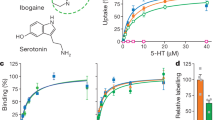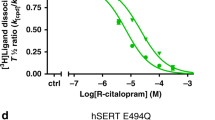Abstract
The serotonin type 3 (5-HT3) receptor is the only ligand-gated ion channel receptor for serotonin (5-HT). 5-HT3 receptors play an important role in modulating the inhibitory action of dopamine in mesocorticolimbic brain regions. Neuroleptic drugs are commonly thought to exert their psychopharmacological action mainly through dopamine and serotonin type 2 (5-HT2) receptors. Except for clozapine, a direct pharmacological interaction of neuroleptics with 5-HT3 receptors has not yet been described. Using the concentration-clamp technique, we investigated the effects of flupentixol, various phenothiazines, haloperidol, clozapine and risperidone on Na+-inward currents through 5-HT3 receptors stably expressed in human embryonic kidney 293 cells, and through endogenous 5-HT3 receptors of murine N1E-115 neuroblastoma cells. In addition, we studied their effects on Ca2+ influx, measured as a change in intracellular Ca2+ concentrations ([Ca2+]i). All neuroleptic drugs, but not risperidone, antagonized Na+- and Ca2+-inward currents evoked by 5-HT (10 μM for 2 s and 1 μM, respectively) in a voltage-independent manner. Only clozapine was a competitive antagonist, while all other compounds turned out to be noncompetitive. Fluphenazine and haloperidol affected membrane anisotropy at concentrations below their IC50 values, indicating that a change in membrane anisotropy might contribute to their antagonistic effect at the 5-HT3 receptor. Only structure analogues of flupentixol and fluphenazine with a lipophilic side chain were potent antagonists against 5-HT-evoked Na+ and Ca2+ currents. Since 5-HT3 receptors modulate mesolimbic and mesocortical dopaminergic activity, the functional antagonism of neuroleptics at 5-HT3 receptors may contribute to their antipsychotic efficacy and may constitute a not yet recognized pharmacological principle of these drugs.
This is a preview of subscription content, access via your institution
Access options
Subscribe to this journal
Receive 12 print issues and online access
$259.00 per year
only $21.58 per issue
Buy this article
- Purchase on Springer Link
- Instant access to full article PDF
Prices may be subject to local taxes which are calculated during checkout










Similar content being viewed by others
References
Barnes NM, Sharp T . A review of central 5-HT receptors and their function. Neuropharmacology 1999; 38: 1083–1152.
van Hooft JA, Vijverberg HP . 5-HT3 receptors and neurotransmitter release in the CNS: a nerve ending story? Trends Neurosci 2000; 23: 605–610.
Ronde P, Nichols RA . High calcium permeability of serotonin 5-HT3 receptors on presynaptic nerve terminals from rat striatum. J Neurochem 1998; 70: 1094–1103.
Sugita S, Shen KZ, North RA . 5-hydroxytryptamine is a fast excitatory transmitter at 5-HT3 receptors in rat amygdala. Neuron 1992; 8: 199–203.
Roerig B, Nelson DA, Katz LC . Fast synaptic signaling by nicotinic acetylcholine and serotonin 5-HT3 receptors in developing visual cortex. J Neurosci 1997; 17: 8353–8362.
Siarey RJ, Andreasen M, Lambert JD . Serotoninergic modulation of excitability in area CA1 of the in vitro rat hippocampus. Neurosci Lett 1995; 199: 211–214.
Costall B, Naylor RJ . Neuropharmacology of 5-HT3 receptor ligands. In: Baumgarten HG, Gothert M (eds). Serotoninergic Neurons and 5-HT Receptors in the CNS. Springer: Berlin, Heidelberg, 2000 pp 409–438.
Zhou FM, Hablitz JJ . Activation of serotonin receptors modulates synaptic transmission in rat cerebral cortex. J Neurophysiol 1999; 82: 2989–2999.
MacDermott AB, Role LW, Siegelbaum SA . Presynaptic ionotropic receptors and the control of transmitter release. Ann Rev Neurosci 1999; 22: 443–485.
Koyama S, Matsumoto N, Kubo C, Akaike N . Presynaptic 5-HT3 receptor-mediated modulation of synaptic GABA release in the mechanically dissociated rat amygdala neurons. J Physiol Lond 2000; 529: 373–383.
Silverstone PH, Greenshaw AJ . 5-HT3 receptor antagonists. Exp Opin Ther Pathol 1996; 6: 471–481.
Reynolds GP . Developments in the drug treatment of schizophrenia. Trends Pharmacol Sci 1992; 13: 116–121.
De Deurwaerdere P, Stinus L, Spampinato U . Opposite change of in vivo dopamine release in the rat nucleus accumbens and striatum that follows electrical stimulation of dorsal raphe nucleus: role of 5-HT3 receptors. J Neurosci 1998; 18: 6528–6538.
Blandina P, Goldfarb J, Green JP . Activation of a 5-HT3 receptor releases dopamine from rat striatal slice. Eur J Pharmacol 1988; 155: 349–350.
Blandina P, Goldfarb J, Craddock-Royal B, Green JP . Release of endogenous dopamine by stimulation of 5-hydroxytryptamine 3 receptors in rat striatum. J Pharmacol Exp Ther 1989; 251: 803–809.
Sorensen SM, Humphreys TM, Palfreyman MG . Effect of acute and chronic MDL 73,147EF, a 5-HT3 receptor antagonist, on A9 and A10 dopamine neurons. Eur J Pharmacol 1989; 163: 115–118.
Costall B, Domeney AM, Naylor RJ, Tyers MB . Effects of the 5-HT3 receptor antagonist, GR38032F, on raised dopaminergic activity in the mesolimbic system of the rat and marmoset brain. Br J Pharmacol 1987; 92: 881–894.
Wang RY, Ashby Jr CR, Zhang JY . Modulation of the A10 dopamine system: electrophysiological studies of the role of 5-HT3-like receptors. Behav Brain Res 1996; 73: 7–10.
Apud JA . The 5-HT3 receptor in mammalian brain: a new target for the development of psychotropic drugs? Neuropsychopharmacol 1993; 8: 117–130.
Newcomer JW, Faustman WO, Zipursky RB, Csernansky JG . Zacopride in schizophrenia: a single-blind serotonin type 3 antagonist trial. Arch Gen Psychiatry 1992; 49: 751–752.
Langer SZ . 25 years since the discovery of presynaptic receptors: present knowledge and future perspectives. Trends Pharmacol Sci 1997; 18: 95–99.
Watling KJ, Beer MS, Stanton JA, Newberry NR . Interaction of the atypical neuroleptic clozapine with 5-HT3 receptors in the cerebral cortex and superior cervical ganglion of the rat. Eur J Pharmacol 1990; 182: 465–472.
Hermann B, Wetzel CH, Pestel E, Zieglgänsberger W, Holsboer F, Rupprecht R . Functional antagonistic properties of clozapine at the 5-HT3 receptor. Biochem Biophys Res Commun 1996; 225: 957–960.
Lankiewicz S, Lobitz N, Wetzel CH, Rupprecht R, Gisselmann G, Hatt H . Molecular cloning, functional expression, and pharmacological characterization of 5-hydroxytryptamine 3 receptor cDNA and its splice variants from guinea pig. Mol Pharmacol 1998; 53: 202–212.
Malone HM, Peters JA, Lambert JJ . Physiological and pharmacological properties of 5-HT3 receptors — a patch clamp study. Neuropeptides 1991; 19: 25–30.
Barann M, Gothert M, Bonisch H, Dybeck A, Urban . 5-HT3 receptors in outside-out patches of N1E-115 neuroblastoma cells: basic properties and effects of pentobarbital. Neuropharmacology 1997; 36: 655–664.
Wetzel CH, Hermann B, Behl C, Pestel E, Rammes G, Zieglgänsberger W et al. Functional antagonism of gonadal steroids at the 5-hydroxytryptamine type 3 receptor. Mol Endocrinol 1998; 12: 1441–1451.
Rammes G, Rupprecht R, Ferrari U, Zieglgänsberger W, Parsons CG . The N-methyl-D-aspartate receptor channel blockers memantine, MRZ 2/579 and other amino-alkyl-cyclohexanes antagonise 5-HT3 receptor currents in cultured HEK-293 and N1E-115 cell systems in a non-competitive manner. Neurosci Lett 2001; 306: 81–84.
Bondy B, Klages U, Muller-Spahn F, Hock C . Cytosolic free [Ca2+] in mononuclear blood cells from demented patients and healthy controls. Eur Arch Psychiatry Clin Neurosci 1994; 243: 224–228.
Munson PJ, Rodbard D . Ligand: a versatile computerized approach for characterization of ligand-binding systems. Anal Biochem 1980; 107: 220–239.
Gimpl G, Fahrenholz F . Human oxytocin receptor in cholesterol-rich vs cholesterol-poor microdomains of the plasma membrane. Eur J Biochem 2000; 267: 2483–2497.
Fan P . Inhibition of a 5-HT3 receptor-mediated current by the selective serotonin uptake inhibitor, fluoxetine. Neurosci Lett 1994; 173: 210–212.
Eisensamer B, Rammes G, Gimpl G, Shapa M, Ferrari U, Hapfelmeier G et al. Antidepressant are functional antagonists at the serotonin type 3 (5-HT3) receptor. Mol Psychiatry 2003; 8: 994–1007.
Blanton MP, Xie Y, Dangott LJ, Cohen JB . The steroid promegestone is a noncompetitive antagonist of the Torpedo nicotinic acetylcholine receptor that interacts with the lipid–protein interface. Mol Pharmacol 1999; 55: 269–278.
Davies PA, Pistis M, Hanna MC, Peters JA, Lambert JJ, Hales TG . The 5-HT3B subunit is a major determinant of serotonin-receptor function. Nature 1999; 397: 359–363.
Hargreaves AC, Lummis SC, Taylor CW . Ca2+ permeability of cloned and native 5-hydroxytryptamine type 3 receptors. Mol Pharmacol 1994; 46: 1120–1128.
Yokota K, Tatebashi H, Matsuo T, Shoge T, Motomura H, Matsuno T et al. The effects of neuroleptics on the GABA-induced Cl− current in rat dorsal root ganglion neurons: differences between some neuroleptics. Br J Pharmacol 2002; 135: 1547–1555.
Terstappen GC, Pula G, Carignani C, Chen MX, Roncarati R . Pharmacological characterisation of the human small conductance calcium-activated potassium channel hSK3 reveals sensitivity to tricyclic antidepressants and antipsychotic phenothiazines. Neuropharmacology 2001; 40: 772–783.
Zhang ZH, Lee YT, Rhodes K, Wang K, Argentieri TM, Wang Q . Inhibitory effects of pimozide on cloned and native voltage-gated potassium channels. Mol Brain Res 2003; 115: 29–38.
Santi CM, Cayabyab FS, Sutton KG, McRory JE, Mezeyova J, Hamming KS et al. Differential inhibition of T-type calcium channels by neuroleptics. J Neurosci 2002; 22: 396–403.
Meneses A . 5-HT system and cognition. Neurosci Biobehav Rev 1999; 23: 1111–1125.
Hodges H, Sowinski P, Turner JJ, Fletcher A . Comparison of the effects of the 5-HT3 receptor antagonists WAY-100579 and ondansetron on spatial learning in the water maze in rats with excitotoxic lesions of the forebrain cholinergic projection system. Psychopharmacology 1996; 125: 146–161.
Arnsten AF, Lin CH, Van Dyck CH, Stanhope KJ . The effects of 5-HT3 receptor antagonists on cognitive performance in aged monkeys. Neurobiol Aging 1997; 18: 21–28.
Greenshaw AJ . Behavioural pharmacology of 5-HT3 receptor antagonists: a critical update on therapeutic potential. Trends Pharmacol Sci 1993; 14: 265–270.
Sunderland T, Cohen BM . Blood to brain distribution of neuroleptics. Psychiatry Res 1987; 20: 299–305.
Cohen BM, Tsuneizumi T, Baldessarini RJ, Campbell A, Babb SM . Differences between antipsychotic drugs in persistence of brain levels and behavioral effects. Psychopharmacology 1992; 108: 338–344.
Tsuneizumi T, Babb SM, Cohen BM . Drug distribution between blood and brain as a determinant of antipsychotic drug effects. Biol Psychiatry 1992; 32: 817–824.
Daniel WA, Syrek M, Haduch A, Wojcikowski J . Pharmacokinetics and metabolism of thioridazine during co-administration of tricyclic antidepressants. Br J Pharmacol 2000; 131: 287–295.
Kornhuber J, Schultz A, Wiltfang J, Meineke I, Gleiter CH, Zochling R et al. Persistence of haloperidol in human brain tissue. Am J Psychiatry 1999; 156: 885–890.
Acknowledgements
We thank Iris Bauer, Sonja Wirth, Christiane Rewerts, Sabrina Meyr and Sylvia de Jonge for expert technical assistance. This work was supported by a Tandem Project of the Max-Planck-Society and the Deutsche Forschungsgemeinschaft (DFG) (Ru 426/6-1). Parts of this work are parts from the thesis of Uta Ferrari at the medical faculty, Ludwig-Maximilians-Universität, Munich, Germany.
Author information
Authors and Affiliations
Corresponding author
Rights and permissions
About this article
Cite this article
Rammes, G., Eisensamer, B., Ferrari, U. et al. Antipsychotic drugs antagonize human serotonin type 3 receptor currents in a noncompetitive manner. Mol Psychiatry 9, 846–858 (2004). https://doi.org/10.1038/sj.mp.4001490
Received:
Revised:
Accepted:
Published:
Issue Date:
DOI: https://doi.org/10.1038/sj.mp.4001490
Keywords
This article is cited by
-
Selective 5HT3 antagonists and sensory processing: a systematic review
Neuropsychopharmacology (2022)
-
Mismatch negativity as an index of target engagement for excitation/inhibition-based treatment development: a double-blind, placebo-controlled, randomized, single-dose cross-over study of the serotonin type-3 receptor antagonist CVN058
Neuropsychopharmacology (2022)
-
Exercise-induced hippocampal neurogenesis: 5-HT3 receptor antagonism by antipsychotics as a potential limiting factor in Schizophrenia
Molecular Psychiatry (2018)
-
Clozapine-induced acute gastrointestinal necrosis: a case report
Journal of Medical Case Reports (2017)
-
The alpha-7 nicotinic receptor partial agonist/5-HT3 antagonist RG3487 enhances cortical and hippocampal dopamine and acetylcholine release
Psychopharmacology (2014)



